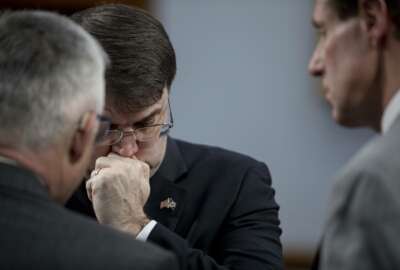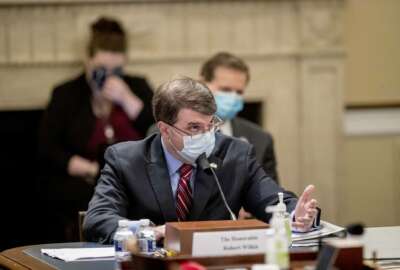

Though the Department of Veterans Affairs over-projected the impact the coronavirus pandemic would have on the veterans population, the agency said it's preparing...
As lawmakers attempt to return to some semblance of “normal” business in the summer months, Congress is contemplating just how it’ll possibly plan out a budget for the next year with all the unknowns of the ongoing pandemic.
The challenge is no more difficult than at the Department of Veterans Affairs, where the rapidly changing nature of the pandemic has forced leadership to reevaluate its budget needs and re-prioritize previously existing projects.
In the early days of the pandemic, VA had projected some 200,000-to-300,000 veterans could become infected with the virus.
To date, roughly 12,000 out of the nation’s 9.5 million veterans have been diagnosed with coronavirus, according to VA data.
“We anticipated 2-to-3% of the population would be infected; we’re dealing with a fraction of that,” Richard Stone, executive-in-charge of the Veterans Health Administration, told the Senate Veterans Affairs Committee Wednesday. “We’re dealing with a tenth of that.”
Of the $19.6 billion the department received from Congress in emergency supplemental funding through the Coronavirus Aid, Relief and Economic Security (CARES) Act, VA has spent roughly $1 billion on medical services.
It hasn’t been often that VA has over-predicted how much funding it requires from Congress. In the days of the VA Choice Act, the department struggled to predict how much veterans would tap into community care providers, with Congress scrambling to pass additional, emergency funding.
Today, VA Secretary Robert Wilkie said the department is holding on tight to that additional funding for two reasons.
It’s both preparing for a potential rebound of the coronavirus in the fall and planning to reprioritize and possibly transfer funds to places with greater need.
“What VA must be concerned about is its ability take care of sick people. About 20% of the positives are really sick,” Stone said. “Do we have enough beds, do we have enough equipment, do we have enough personnel to care for them? Hence the reconfiguration of the VA’s delivery system to grow by almost 4,000 beds as we went through this, and the hiring of massive numbers of people.”
“VA is well-positioned to remain the backstop of the American health care system,” he added.
Stone said he couldn’t begin to predict whether the country would in fact experience a second, perhaps more severe spike of coronavirus cases in the fall. The department does, however, anticipate treating 600 veterans as inpatients for the virus through the fall.
As the department prepares for the possibility of significantly more cases in the fall, it’s also balancing the need to catch up on a few VA initiatives that were delayed or stalled during the pandemic.
Those projects will take some extra cash, VA said; it just needs the transfer authority to move funds from one priority to another.
“We did not get all the money in the right places, Jon Rychalski, VA’s chief financial officer, said of the CARES Act supplemental funding. “We do have a real need to move some of that CARES money into the Veterans Benefits Administration, not a large amount, some into the National Cemetery Administration and some into IT as well. Those are three areas where we’re going to be short.”
VBA, for example, is now facing a backlog of 119,000 compensation and pension exams, up nearly 5,000 in one week.
The department canceled in-person compensation and pension exams in early April for veterans seeking disability benefits. Though VA recently announced in-person exams at some facilities would resume in the next few weeks, the agency will need to pay its employees overtime to work quickly through the backlog.
The electronic health record is another VA project that’s stalled during the pandemic, though its path forward has less clarity. Before the pandemic, the department had set July as a tentative goal for the rollout of initial EHR capabilities in Spokane, Washington.
But VA took its clinicians off the project and instructed Cerner contractors working at the Spokane facility to turn the space back to the hospital in the early days of the pandemic.
“I don’t really want to talk about this, but I have to,” said Jon Tester (D-Mont.), ranking member of the Senate committee, who noted VA had spent roughly $2.5 billion on EHR modernization so far.
“I know you’ve been impacted by COVID, but what we have done so far?” he said. “Do we have value for the money we’ve spent, and what kind of timeline really are we on here to get this up and going? And is it going to be user-friendly enough so we don’t have send doctors and nurses to training for a month to be able to get them to understand how to use the damn record when they should be treating patients?”
Wilkie described the EHR modernization as a “good news story,” noting VA and the Defense Department’s success in launching the Joint Health Information Exchange in mid-April.
“We’re going to be going live on the scheduling portion in Columbus, Ohio, and then I expect Spokane and later Seattle will be up and running later this year,” he said.
Copyright © 2025 Federal News Network. All rights reserved. This website is not intended for users located within the European Economic Area.
Nicole Ogrysko is a reporter for Federal News Network focusing on the federal workforce and federal pay and benefits.
Follow @nogryskoWFED



